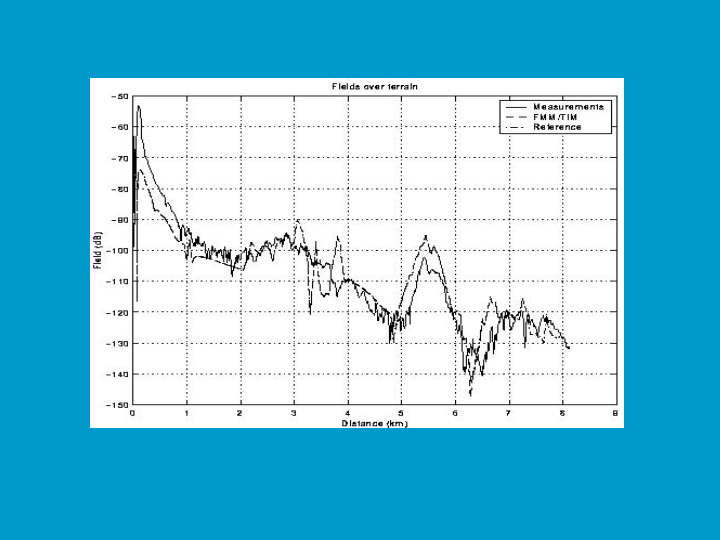 Integral equations
Integral equationsOne of our areas of interest is in propagation modelling for use in the planning of wireless systems and in acoustics. Along with our collaborators in the Radio Propagation Group TCD, we have significant expertise in several computational techniques most notably:
 Integral equations
Integral equations
 Parabolic equations
Parabolic equations
 Uniform theory of diffraction (ray tracing)
Uniform theory of diffraction (ray tracing)
 Physical Optics
Physical Optics
 Empirical methods
Empirical methods
We present here a very brief selection of some indicative research results. The figure below is of fields calculated above a terrain profile using the 2D electric field integral equation (EFIE). The terrain information and measured data (shown in subsequent figure) was generously provided by Prof. Bach Andersen of the University of Aalborg.

A major focus of our research has been on the development of efficient solutions to the integral equation formulation of the terrain propagation problem. The solution of this problem is extremely computationally onerous if performed using traditional (forward scattering) methods. Our techniques instead are predicated on the use of acceleration methods such as the fast multipole method and the fast far-field method. In particular, the tabulated interaction method (TIM) is a basis set approach which is based on the underlying approximations of the two dimensional fast multipole method.

The above plot shows a comparison between the fields calculated over a 10km stretch of terrain using an exact forward scattering IE approach, those calculated using an Ray Propagation Fast Multipole Algorithm / Tabulated Interaction Method (RPFMA/TIM) approach and data measured. The operating frequency in this case was 970MHz. There is an almost perfect agreement between the reference integral equation fields and those given by the significantly more efficient RPFMA/TIM. Both integral equation results agree extremely with the measured data.
Another research area of interest is the use of asymptotic methods such as the uniform theory of diffraction to compute the fields propagating in complicated urban or indoor environments. Such an analysis relies on the computation of all significant interaction paths by some sort of three-dimensional ray-tracing engine. The figure below presents fields computed in a two-dimensional plane in a simple building plan, using a three dimensional ray-tracing code developed in DCU.

This ray-tracing code has been used to develop a three-dimensional
user tracking algorithm. Click here for a presentation given by Szymon Fedor a student on the school of electronics taught masters course.